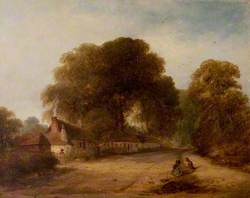How you can use this image
This image can be used for non-commercial research or private study purposes, and other UK exceptions to copyright permitted to users based in the United Kingdom under the Copyright, Designs and Patents Act 1988, as amended and revised. Any other type of use will need to be cleared with the rights holder(s).
Review the copyright credit lines that are located underneath the image, as these indicate who manages the copyright (©) within the artwork, and the photographic rights within the image.
The collection that owns the artwork may have more information on their own website about permitted uses and image licensing options.
Review our guidance pages which explain how you can reuse images, how to credit an image and how to find images in the public domain or with a Creative Commons licence available.
Notes
Add or edit a note on this artwork that only you can see. You can find notes again by going to the ‘Notes’ section of your account.
The smooth-bore barrel is damascened in gold and bears Arabic invocations and a Persian distych punning on the word kundak (in the senses of 'swaddling clothes' and 'gun-stock', i.e. tiny but deadly). The ramrod is held in place by two silver bands. The stock, made from wood of the plane tree (Platanus orientalis, Ottoman, çinar) has an ivory butt-cap inlaid with gold or gilt-brass studs and wire, green-stained ivory and bone and silver rosettes, which bears a silver chain wrist-strap. Seventeenth-century Ottoman flintlock pistols are rare outside the Turkish state collections. Among the few exceptions are one in Dresden, and two pairs in the Karlsruher Türkenbeute. There are also two pistols in the Topkapi Palace collection: one bears a tughra of Ahmed III (r.
Title
Flintlock Pistol
Date
17th C
Medium
wood, steel, ivory or bone, silver, gold or gilt-brass wire & gold damascening
Accession number
906
Work type
Sculpture








